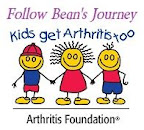The first thought that popped into my head?
Arthritis Foundation...that isn't my thing...
See, for the past 7 years our family has focused our time and fundraising "walks" on the Race for Hope J's dad died October 9, 2002 from a brain tumor.
Bean was named for him.
She was born on my in-laws' anniversary.
A bright light after the sad loss of a 57 year old gentle and kind man.
Brain cancer is our cause...Arthritis...
If I make the call, does that make the journey real? Do I make that call?
I don't know if I'm ready for that.
Well, I didn't have to be ready, with my permission, my friend's mom - C - the wife of a Rheumatologist, made the connection for me and had the Arthritis Foundation contact me.
They asked if I wanted to get involved...if I wanted a welcome package. I heard the words come out of my mouth "yes."
But it wasn't really what I wanted to say. I wanted to say, no - I don't want a welcome package, I don't want to get involved...I don't want my daughter to have arthritis...I mean, if I do say yes it means this is real, that my baby has arthritis...that she is on a chemo drug...that she has pain...that she has to deal with this and not just get better while we wait it out.
But, I said yes.
Today my package came - Thank you C for helping me take this first step:






